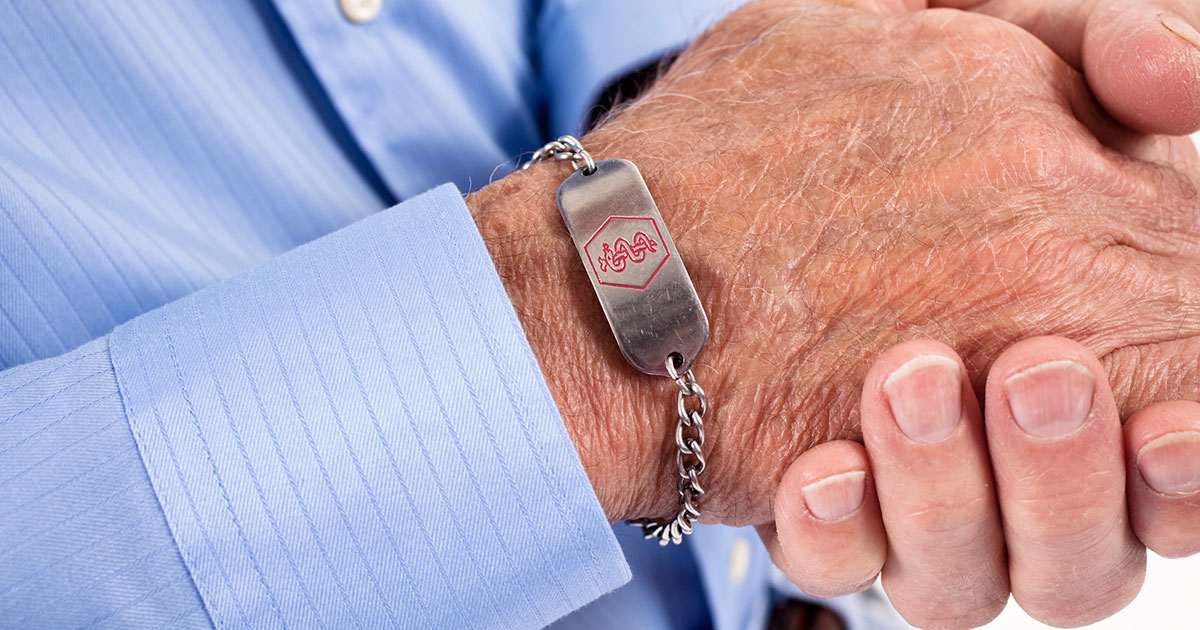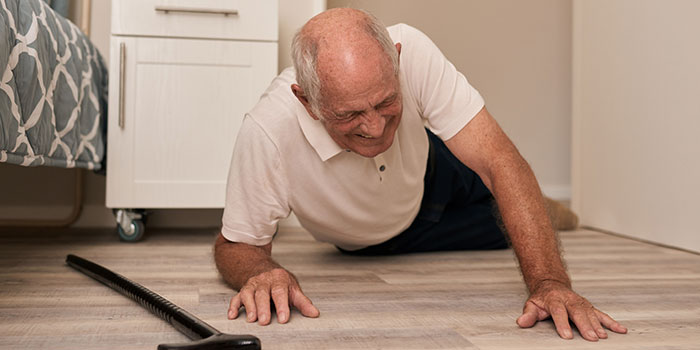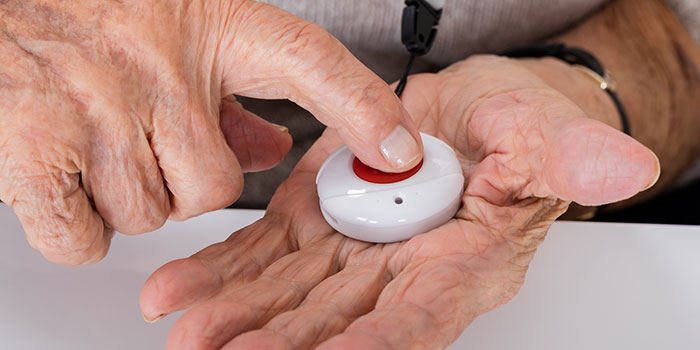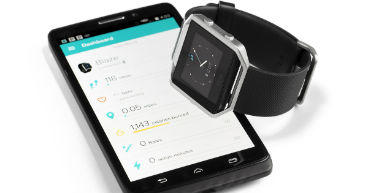
When a TV commercial for a medical alert system began airing in the 1980s, its common catchphrase quickly caught on as a punchline: “I’ve fallen, and I can’t get up.”
But if you consider what could happen if you take a fall and become injured or unconscious when you’re home alone, it’s no laughing matter. And if you’re running errands when, suddenly, you can’t catch your breath or call out for help, that’s serious business.
If you’re a cancer patient or someone with a serious or chronic illness or severe allergies, it’s important to be aware and proactive in protecting yourself in case you have a personal medical emergency, especially if you live alone. If you’re unable to speak due to a health crisis, being able to communicate your vital health information—including your medical conditions, medications and allergies—to emergency medical technicians (EMTs) may save your life.
In this article, we’ll discuss:
- The origins of medical alert devices
- Who should wear a medical alert device
- How medical alert devices may benefit cancer patients
- Choosing the right medical alert device for you
- What information should be included on a medical alert device?
If you’ve been diagnosed with cancer and are interested in a second opinion on your diagnosis and treatment plan, call us or chat online with a member of our team.
The origins of medical alert devices
Since the 1950s, medical alert bracelets, usually made of metal or silicone, have been worn by millions of people as a safety precaution in the event of an unexpected medical crisis. Dr. Marion Collins, founder of MedicAlert® Foundation, claims to have developed the first medical ID bracelet.
When Dr. Collins’ daughter, Linda, was 14 years old, she cut herself and needed stitches. In the emergency room, the physician took the normal course of action and administered a tetanus shot. However, Linda suffered a near-fatal allergic reaction and went into a coma. Dr. Collins knew of Linda’s allergy but was out of town when she was injured. His daughter recuperated from the incident, and in 1956, Dr. Collins started the MedicAlert Foundation, a nonprofit organization whose mission is “to save and protect lives by sharing information in members’ moment of need.”
The design for the first bracelet, which included the star of life and the staff of Asclepius, the Greek god of medicine and healing, is still used on medical ID bracelets and necklaces today.
In recent years, in addition to medical ID jewelry, smart medical alert devices have become readily available. These include wearable buttons, wallet cards, luggage tags and smartphone apps capable of notifying emergency responders in case of a health crisis.
Many smart devices offer access to 24/7 medical monitoring services staffed by professionals trained to access your stored health data and communicate the appropriate information to EMTs and physicians.
Any of these devices help relay your specific health requirements so emergency services know to avoid specific treatment protocols, such as IV drugs or other invasive procedures that may interact with your current treatments or allergies and cause a life-threatening reaction.

Who should wear a medical alert device?
“Anyone with a medical condition, including cancer patients, should consider wearing some sort of medical ID or use a medical monitoring system,” says Amanda Pate, MSN, RN-BC, OCN, Nurse Manager of Clinical Program Operations and the Continuous Care Virtual Clinic at City of Hope Atlanta.
“Medical monitoring enables patients and caregivers to be proactive rather than reactive. It makes it possible to notice small health changes, such as a blood pressure drop, and adjust medications before a major medical event occurs,” Pate says. “Ultimately, the goal is to prevent patients from having to make an emergency trip to the hospital.”
Most health care experts agree that anyone who is or could become unable to call for emergency services should have a medical alert device and consider investing in a medical monitoring system. Candidates for these devices include:
Those who live alone
Older people and those with physical disabilities who live alone are at greater risk for falling or injuring themselves. Consider a medical alert monitoring system if you don’t have family members close by or if you don’t always carry a cellphone.
People at risk of falling
Falling is such a health risk that the U.S. Centers for Disease Control and Prevention cautions older adults and those with serious health conditions to learn the facts about this hazard, which may result in a serious head injury, broken bones or hip fracture. One in four adults over the age of 65 suffers a fall-related injury every year.
Anyone with serious health conditions
Any condition or disability that could limit your movement, perception or reaction time is considered serious. Common conditions include:
- Allergies
- Alzheimer's or memory impairment
- Cardiac problems (angina, arrhythmias, atrial fibrillation, pacemakers)
- Diabetes
- Blood disorders
- Emphysema or other breathing disorders
- Epilepsy or other seizure disorders
- Kidney disease
- Lung conditions (including asthma/COPD)
- Cancer
- Stroke risk
- Sickle cell anemia
Also, those participating in clinical trials, taking multiple medications or recovering from surgery or a transplant may want to consider getting a medical alert device.
How medical alert devices benefit cancer patients
Many cancer patients experience treatment side effects that, if left undetected or untreated, may land them in a hospital emergency room. “Certain types of chemotherapy treatments are likely to increase a patient’s blood glucose level, which may cause blurry vision and lightheadedness. Other treatments may result in shortness of breath or pain,” Pate says. “If symptoms occur when a patient is running errands or at home alone, accidents may occur.”
In a crisis, a medical ID bracelet or necklace engraved with your health information will inform EMTs and emergency physicians so they can better administer care that won’t harm you. However, for some cancer patients, including those at high risk due to multiple health conditions, a remote monitoring system may be a better choice.
Monitoring systems consistently track patients’ vital signs so even slight changes alert health care providers that adjustments to medication or other treatment may be needed. Using remote monitoring for some cancer patients during the 30 days following their hospital discharge has helped reduce the number of patients who are re-admitted at City of Hope Atlanta, according to Pate.
“Whichever monitoring system cancer patients choose, they should be sure the responders on the phone are specifically trained in the cancer drugs they’re being treated with and have the clinical knowledge to manage the symptoms they’re experiencing,” Pate says.
A medical alert system may help cancer patients:
- Enjoy greater peace of mind
- Ensure appropriate and timely medical care
- Avoid medical errors or misdiagnosis
- Avoid unnecessary hospitalization
Choosing the right medical alert device for you
Dozens of medical alert devices are available, and prices vary widely, from $20 for a bracelet engraved with your medical info to over $150 for an electronic monitoring smart watch that stores your health profile. If you want 24/7 monitoring, be prepared to also pay a subscription fee ranging from $25 to $75 per month.
Before subscribing to a monitoring service, consider which options you may need, since these may increase your monthly rate.
Home-based vs. on-the-go package: A home-based device only includes a home base station (not a wearable device). If you leave the house for any reason, you’ll want a device that’s effective no matter where you go.
An alert button: Most on-the-go systems include a button you wear on your body in addition to the home base station. When you press the alert button, you’re immediately connected to a dispatcher, who will send for help.
Landline vs. cellphone: Most services give you the option of operating the device via a landline telephone or with your cellphone service. Just know that using your cell provider will cost a bit more.
Caregiver phone app: Some devices include a phone app that can be shared with a loved one, so he or she is automatically alerted in an emergency.
A fall detector: This feature automatically alerts the dispatch center at your monitoring service if you fall.
GPS location tracking: This feature may be especially useful for adults with memory problems or autism.
Medical records storage: Some systems allow you to upload your health records, such as your recent hospital visits or surgeries, into a secure database. In an emergency, the records are accessible by health care professionals.
You may also opt for a non-monitored electronic alert device such as Tap2Tag, which uses near-field communication (NFC) to relay your health data in an emergency. NFC allows paramedics to access the health information you store on a secure website by connecting their phones to your Tap2Tag wrist band.
“Regardless of the type of medical alert ID you choose, be sure the device is easy for you to use,” Pate says. “Also, if you’re self-reporting medical information that’ll be used for monitoring, including your weight, oxygen levels and blood pressure, be as accurate as possible even minor changes should be reported, since they may help identify a health issue before it becomes a problem.”
What information should be included on a medical alert device?
The industry hasn’t developed official standards for which types of information should be included on your medical ID or electronic profile, and doctors aren’t required to check them for accuracy. One study published by the Association of Anesthetists in the United Kingdom outlines several guidelines to help patients use medical bracelets and alert devices to communicate their vital health information if they become incapacitated.
The guidelines are:
- The device should be identifiable as a medical alert (easily distinguishable from fashion jewelry). The star of life and the staff of Asclepius are readily recognizable by EMTs.
- It’s a good idea to have your physician review the wording of the information engraved on your bracelet or, for an electronic device, stored on your electronic profile to have.
- Only include information that’s not discoverable by a clinician if you become unconscious. (For example, it may not be necessary to include your blood type.)
- Only include information relevant to a life-saving event. Information considered relevant includes:
- Your first and last name
- Serious health conditions (type of cancer, diabetes, etc.)
- Medications you take (You may not need to list all medications. Talk to your doctor about which ones to include to avoid potential interactions.)
- Dangerous allergies (Be specific about drugs and items, such as latex.)
- Medical advice—for example, if you have a pacemaker or an organ transplant
- Emergency contact phone numbers for your spouse and/or caregivers
The study also recommends updating the health information used for your medical device on a regular basis. Pate, who is also a volunteer firefighter, agrees: “Emergency responders are trained to look for and respond to the information on their patients’ medical ID bracelet, cellphone or other alert device. You may help them keep you safe by keeping your device up to date.”
If you’ve been diagnosed with cancer and are interested in a second opinion on your diagnosis and treatment plan, call us or chat online with a member of our team.


